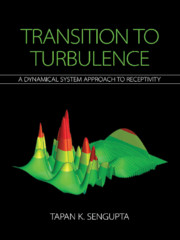Book contents
- Frontmatter
- Dedication
- Contents
- Preface
- 1 Receptivity, Instability, and Transition: A Perspective
- 2 Dynamical System Theory and Role of Equilibrium Flows
- 3 Fundamentals of Scientific Computing
- 4 Instability and Transition
- 5 Receptivity Analysis: Relation with Instability Experiments
- 6 Dynamical System Theory of Linear Receptivity
- 7 Nonlinear, Nonparallel Effects on Receptivity, Instability, and Transition
- 8 Three-Dimensional Routes of Transition to Turbulence
- 9 Receptivity to Free Stream Excitation: Theory, Computations, and Experiments
- 10 Nonlinear Receptivity Theories: Hopf Bifurcations and Proper Orthogonal Decomposition for Instability Studies
- 11 Mixed Convection Flow
- 12 Baroclinic Instability: Rayleigh–Taylor Instability
- 13 Coherent Structure Tracking in Transitional and Turbulent Flows
- 14 The Route of Transition to Turbulence: Solution of Global Nonlinear Navier–Stokes Equation
- References
5 - Receptivity Analysis: Relation with Instability Experiments
Published online by Cambridge University Press: 16 February 2021
- Frontmatter
- Dedication
- Contents
- Preface
- 1 Receptivity, Instability, and Transition: A Perspective
- 2 Dynamical System Theory and Role of Equilibrium Flows
- 3 Fundamentals of Scientific Computing
- 4 Instability and Transition
- 5 Receptivity Analysis: Relation with Instability Experiments
- 6 Dynamical System Theory of Linear Receptivity
- 7 Nonlinear, Nonparallel Effects on Receptivity, Instability, and Transition
- 8 Three-Dimensional Routes of Transition to Turbulence
- 9 Receptivity to Free Stream Excitation: Theory, Computations, and Experiments
- 10 Nonlinear Receptivity Theories: Hopf Bifurcations and Proper Orthogonal Decomposition for Instability Studies
- 11 Mixed Convection Flow
- 12 Baroclinic Instability: Rayleigh–Taylor Instability
- 13 Coherent Structure Tracking in Transitional and Turbulent Flows
- 14 The Route of Transition to Turbulence: Solution of Global Nonlinear Navier–Stokes Equation
- References
Summary
Introduction
In Chapter 1, we have discussed chronologically the theory of instability, starting with the works of Helmholtz [177], Reynolds [365], Rayleigh [351], and Kelvin [224], purely as a discourse about the different facets of the phenomena that we identify as the transition to turbulence. Although laminar flow can be stationary, background disturbances grow in space and time to create turbulent flow. Thus, the main issue in transition research is in identifying how disturbances display spatio-temporal growth. The research built upon the idea of imperceptible disturbances feeding upon the equilibrium flow and the resultant growth being so overwhelming that it takes the initial equilibrium state to another state that will be space–time dependent. Although it is imperative to explain how turbulence comes into being, there remain a few unexplored steps following which the laminar flow becomes transitional and turbulent. In the previous chapter, we emphasized the role of instability studies in this search, but one of the central issues of establishing any instability theory posed as an eigenvalue problem, lies in the difficulty of physically verifying such a theory. There was a major roadblock in experimentally verifying instability theories that continued till very recently. The subject started with the erroneous concept that viscous action is dissipative, and hence, an inviscid theory was considered appropriate and the theorems due to Rayleigh and FjØrtoft came into existence to explain temporal growth of inviscid disturbances. Prior to this investigation, Rayleigh [350] was successful in explaining the motion of jets by this temporal theory. However, this could not explain the instability of flow over a flat plate, and two new concepts came to the forefront. First, the significance and importance of viscous actions was seized upon, as diffusive actions were known to create instabilities for various mechanical and electro-mechanical systems. Second, as a reaction to the failure of temporal growth of disturbances for the zero pressure gradient boundary layer, researchers started on the path of spatial instability theory. In this theory, one has to fix a time scale and look for complex wavenumbers which satisfies the basic requirements of eigenvalue analysis. We have noted the discovery of Tollmien–Schlichting (TS) waves from this theory, proved to be difficult to verify experimentally.
- Type
- Chapter
- Information
- Transition to TurbulenceA Dynamical System Approach to Receptivity, pp. 155 - 193Publisher: Cambridge University PressPrint publication year: 2021



